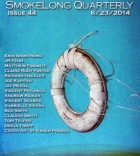I was struck by the fact that Ikechi has spent most of his life feeling caricatured or cartoon-like. What inspired you to come up with that concept?
Fear is the real reason he imagines himself as a cartoon figure. He doesn’t want to cough; he doesn’t want to bleed. A cartoon character is free from the possibility of suffering. Not only that but there’s a comic element. The real world below loses its power and intensity for him when he sees himself in a comic mode. He is above it rather than reduced by it.
I love the final image—Ikechi, in his Shrek costume, floating on air above Trafalgar Square. Do people in costumes frequent Trafalgar Square the way that they do Times Square or the Walk of Stars in Hollywood?
Yes, there are people in costumes in Trafalgar Square, London, and also in Covent Garden.
One of the things I enjoy about this piece is that you capture so much of a character—the essence of his life, really—so beautifully and so succinctly. How do you approach creating a piece of flash?
I’m new to flash, though I am a short story writer. My approach is similar in both cases but the exciting thing about flash is that you can conjure up all in a flash the ideas about the character that have started simmering inside you.
If you could tell Ikechi one thing, what would it be?
I am a verbal person and I guess Ikechi isn’t that. He expresses how he feels through this creation of himself as a human statue. I see him but I don’t think he could see me. We have a different approach to life. He is managing things in his own way. I don’t think I could really tell him anything that he would care to hear.



 The core workshop of SmokeLong Fitness is all in writing, so you can take part from anywhere at anytime. We are excited about creating a supportive, consistent and structured environment for flash writers to work on their craft in a community. We are thrilled and proud to say that our workshop participants have won, placed, or been listed in every major flash competition. Community works.
The core workshop of SmokeLong Fitness is all in writing, so you can take part from anywhere at anytime. We are excited about creating a supportive, consistent and structured environment for flash writers to work on their craft in a community. We are thrilled and proud to say that our workshop participants have won, placed, or been listed in every major flash competition. Community works.